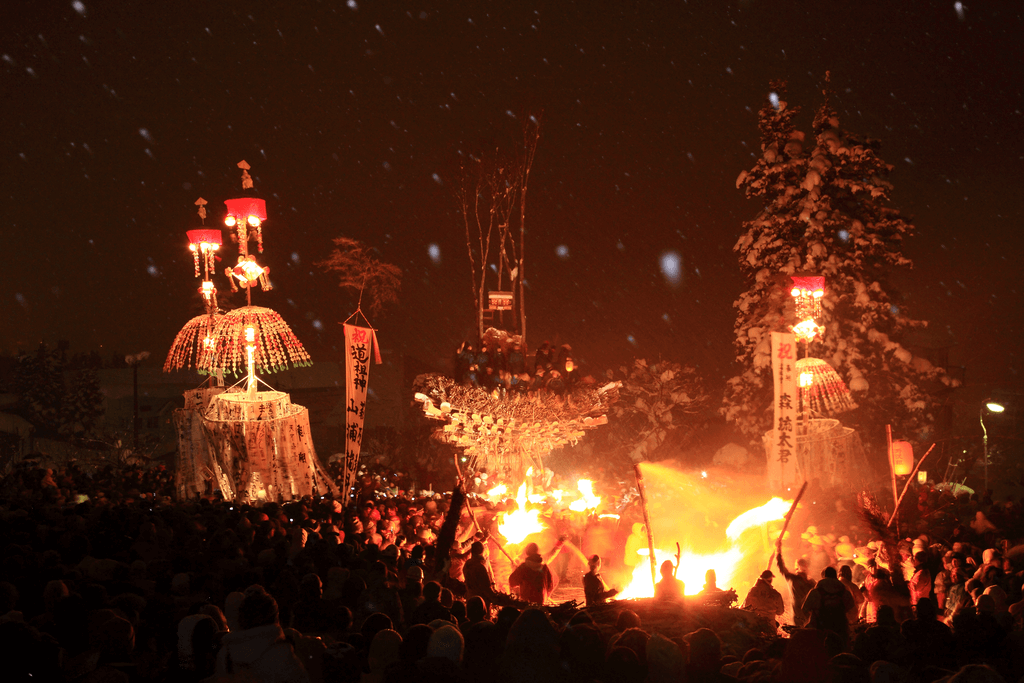Put these events on your January calendar! As winter comes to Japan, many festivals appear, waiting to ignite your spirit and warm your heart! From the delightful Zao Snow Monster Festival to the wild Nozawa Fire Festival, January is full of cultural celebrations you can’t miss! Let’s look at some of the best five festivals across Japan that you should put on your January calendar!
Table of Contents
ToggleZao Snow Monster Festival (December 23-February 25)
Zao Onsen is a famous ski resort with many courses, making it popular for winter sports enthusiasts. In December, the Zao Snow Monster Festival shows off the mountain’s natural beauty with the juhyo, or snow monsters. The snow monsters are created when freezing winds and snow cover and freeze over the trees in the mountains! These natural sculptures are also illuminated from late December to late February, giving a magical view from the ropeway.

The festival includes dynamic demonstrations, performances by senior skiers, and events unique to hot springs. For a magical experience, take the Juhyo Fantasy Corridor tour, a 70-minute ride on the ropeway, or the Night Cruiser to see the snow monsters. Finally, the festival ends with a Torch Ski event, where skiers carry torches down the slopes, creating a fantastic atmosphere. Take your chance to see the Zao Snow Monsters!
Oni Hashiri (January 14)
On January 14 each year in Nara Prefecture’s Gojo City, the Dadado-no-Oni-Hashiri ritual at Nenbutsu Temple blazes as a festival of fire! Join the locals as they dress as demons and run around the temple, creating a wild atmosphere! More specifically, the event depicts father, mother, and child ogre hold flaming torches, driving away bad luck to welcome spring. This ancient tradition shows the demons as symbols of fortune and happiness rather than evil.

The tradition started over five hundred years ago. More specifically, the ceremony features daytime demon runs, a fire ritual, and a breathtaking nighttime Demon Run. During this segment, ogres bring a magical atmosphere to the temple grounds. The ogres also carry their torches and run around the hall three times, creating a beautiful sea of fire. All in all, this unique portrayal of demons bringing luck is rare in Japan, attracting pilgrims eager to witness the event’s historical and cultural significance.
Chitose and Lake Shikotsu Ice Festival (January 28-February 23)
The Chitose and Lake Shikotsu Ice Festival transforms the shores of the lake into a frozen wonderland. Ice sculptures, created from the lake’s clear waters, also take on a beautiful glow as they are illuminated in vibrant colors at night. Generally, the festivities extend into the evening with fireworks and Wadaiko drum performances on Saturdays and Sundays. Visitors can also relax at the nearby hot springs and enjoy baths, meals, and souvenir shopping.

Beyond the stunning sculptures, visitors can enjoy various activities such as ice skating, sliding down the ice slide, and horseback riding. The festival also offers food stalls featuring Japanese classics like oden, hot soba, and udon noodles. Additionally, it’s famous for its many attractions, like the Blue Chateau, where a spiral staircase leads to a seven-meter-tall observatory, the awe-inspiring Ice Wall, and an enchanting ice tunnel leading to a beautiful ice chandelier.
Are you interested in amazing snacks to enjoy while enjoying these amazing events? Sakuraco delivers traditional Japanese snacks, teas, and sweets from local Japanese makers directly to your door so you can enjoy the latest delicacies directly from Japan!
Toka Ebisu Festival (January 8-12)
The annual Tōka Ebisu festival takes place at Kyoto Ebisu Shrine over five days and celebrates the birthday of the enshrined god, Ebisu, the god of fishermen and business. Thousands flock to the small Gion area shrine to pray for success in their businesses in the coming year. Festivalgoers participate in religious ceremonies, purchase lucky charms for their businesses, and eat delicious festival food while enjoying the fun atmosphere.

Special rituals, including the Yudate Kagura Ritual, mochi making, the Lucky Maguro Tuna Dedication, and a palanquin procession, contribute to the festive ambiance, with attendees often participating in a unique tradition of knocking on a wooden panel behind the shrine to make sure Ebisu hears their wishes. There are also days when women in traditional clothing will be at the shine to hand out bamboo that a shrine maiden has blessed.
Nozawa Fire Festival (January 15)
The Nozawa Onsen Fire Festival, celebrated on January 15th, is one of Japan’s top three fire festivals. This event features a symbolic battle where 42-year-olds and 25-year-olds, traditionally considered unlucky ages in Japan, participate in a fiery battle to protect a temporary shrine, built a day in advance, called shaden, from fellow villagers wielding flaming torches. The structure honors Dosojin, a god of roads and borders believed to protect travelers.

The event represents prayers for a family’s first child, good health, and a robust harvest. The festival schedule includes a special fire creation ceremony, lantern lighting, fireworks, singing, and drumming. The intense battle begins around 8:30 p.m., lasting up to three hours when the shrine goes up in flames. This cultural festival attracts many visitors with its tradition, fire, and celebration blend!
Why should I put these events on my January calendar?
As the winter transforms Japan, these festivals show off Japan’s seasonal traditions, which can brighten up anyone’s January calendar! It’s an opportunity to create lasting memories and enjoy Japan during one of its most enchanting seasons. Let these festivals fill your winter days with warmth and wonder!
Share in these unique celebrations and embrace the spirit of community and tradition! All in all, make room in your calendar for these captivating events! Which of these festivals are you putting on your January calendar? Have you attended any of them before? Let us know in the comments below!










